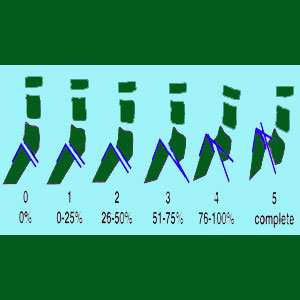
Vertebral slippage is an alternative diagnostic terminology for spondylolisthesis. Vertebral can slip forward (called anterolisthesis) or backward (called retrolisthesis) in relation to surrounding spinal bones. The degree of slippage relative to the neighboring vertebral bones will be used to classify the clinical significance of the condition according to the spondylolisthesis grading scale of 1 to 4.
Slippage can occur for several known reasons, but might also be idiopathic is some patient profiles. Slippage might self-limiting or might continue to progress to become a potentially symptomatic condition that may require dramatic medical intervention.
This unique essay takes an intimate look at spinal bone slippage and what the condition means for affected individuals with a wide range of different grades of spondylolisthesis.
Vertebral Slippage Grade 1 and 2
The least clinically severe classification for vertebral slippage is called grade 1. This level of vertebral migration encompasses anterolisthesis and retrolisthesis changes that amount to less than 25% vertebral displacement compared to objective normal anatomical position. Most doctors will not consider slippage of less than 10% as qualifying to be called true spondylolisthesis, but instead will classify these slight irregularities as falling within the normal range of variation for human anatomy.
Grade 2 spondylolisthesis is rated at more than 25% slippage, but not more than 50% slippage in relation to the surrounding vertebral bones. On the low end on this rather broad rating scale, the condition greatly resembles grade 1 cases. Meanwhile, on the upper end of the spectrum, the condition might more closely resemble grade 3 classifications of listhesis.
The overwhelming majority of all diagnosed spondylolisthesis qualified to be rated as grade 1, while a significant portion of cases are rated at grade 2. Neither grading is considered inherently symptomatic or even pathological from a medical viewpoint. However, most physicians would agree that all listhesis conditions should be regularly monitored for progression or the start of any symptomatic activity.
Vertebral Migration Grade 3 and 4
Grade 3 spondylolisthesis rated at more than 50% relative migration, but no more than 75% comparative slippage to neighboring vertebral bones. Grade 3 listhesis is considered clinically significant and can be symptomatic. This form accounts for only a small minority of total cases worldwide.
Finally, grade 4 slippage is considered more than 75% slippage. These vertebral migration concerns are mostly symptom-generating and are usually considered universally pathological, even when they do not create pain in specific individuals. Grade 4 listhesis is the least often seen clinically and accounts for the smallest number of affected patients worldwide.
Note: Some physicians utilize a fifth grade of listhesis to the classification scale, called Grade 5, which accounts for patients who demonstrate vertebral migration rated at over 100% or more than complete slippage. This last category is not universally utilized by diagnosticians and really only accounts for the very worst cases of listhesis that are rarely observed anyway.
Vertebral Slippage Factsheet
Listhesis sounds very frightening. The idea of one or more vertebral bones moving out of normal alignment in the spine definitively scares patients as a sign of impending anatomical disaster. However, these fears do not accurately represent the facts of most cases of spondylolisthesis.
It is true that the most severe cases can be nightmarish in symptomology and may require very dramatic and invasive surgical procedures to stabilize and correct. However, these profiles do not represent the average case in any way. Most listhesis is minor to moderate, not symptomatic or not overly symptomatic, and not necessitating any type of special treatment.
Most typical listhesis is self-limiting in progression, since the integrity of the overall spinal column, as well as the integrity of the specially affected vertebral level, are both maintained, even if the affected level is considered an anatomical atypicality. As long as the slipped vertebra can remain stable, then neurological functionality will not usually become compromised.
For listhesis which does require treatment, doctors can most often fully stabilize the spine and restore neurological function using minimally invasive anterior spinal fusion techniques applied over the compromised vertebral levels.
Spondylolisthesis > Isthmic Spondylolisthesis > Vertebral Slippage



